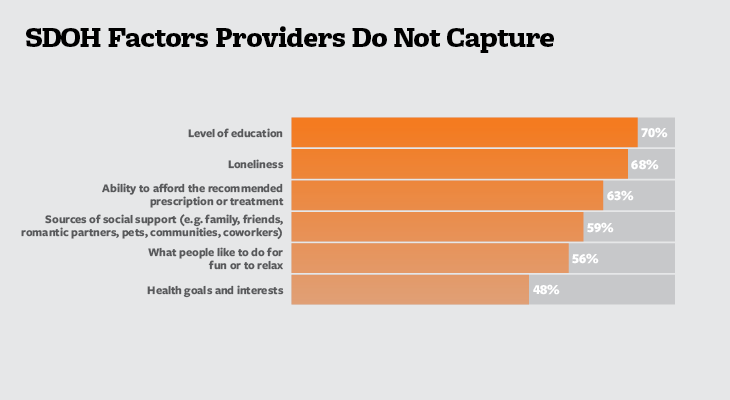2020 was a whirlwind in many ways and changed the delivery of healthcare from both the patient and physician perspectives and accelerated opportunities for collaboration. While consumerism has been a focus in the U.S. for some time, COVID-19 has placed pressure on the healthcare industry to erect a digital front door for patients (telehealth, appointment scheduling, appointment check-in, etc.). In 2021, digital and physical interactions will continue to merge. Consumers are likely to be more actively involved in their care than ever before and will expect experiences that guide them to make the best decisions for themselves and their family to meet them where they are at.
The pandemic has reinforced the idea that the best patient care can be achieved through communication, collaboration, and data sharing. As we create a new normal for how healthcare is delivered, providers need to focus on how to create a personalized experience for patients. How can you know your patient, show them that you know them and anticipate their needs?
COVID-19 is proving that everyday factors can make a big difference in a person’s current and future risks and needs, along with the type of support and preventive actions that are essential to their total wellbeing. Yet, most providers do not have access to the necessary data. Providers need to look beyond clinical information and leverage consumer data, including social determinants of health (SDoH), which are socioeconomic factors and health behaviors that drive 80% of a patient’s health outcome, to better understand their patients. SDoH data not only reveals a person’s health risks today, but it can also be leveraged to anticipate future needs. For example, our predictive data analysis shows that people who rely on public transportation are less likely to comply with preventative care and are thus at higher risk for high-cost events (i.e. emergency department visits). Domestic sedan owners are less likely to have COPD, whereas people in multi-unit dwellings are at a higher risk for COPD.
Consumers say that providers usually ask them about their physical health (i.e. diet, exercise) and emotional health, but not about SDoH factors like education or social connectedness. On top of this, nearly half (48% of people are unaware of what type of information outside of their medical history they should be sharing with their provider to get better support.
This reinforces the importance of supplementing clinical data with consumer data, so providers can get a full 360-degree view of their patient, which will arm them with the knowledge they need to create a personal and long-lasting patient relationship. Strengthening the physician-patient relationship, leads to increased patient satisfaction and trust that will help providers guide their patients towards the care they need.
The aggregation of individual level data is key to the process. “An urgent digital business priority — enhancing the customer relationship — hinges on optimized and integrated master data,” writes Ilona Hansen, Malcom Hawker, and Varun Agarwal in Gartner Research.1 Once the data is ingested, analyzed and organized, clinical, and consumer data can be combined to create a master patient index, meaning one record for each person providing the 360-degree view of the patient. This can give providers a granular understanding of the individuals in their market, as well as the population as a whole. Again, without this breadth and depth of data, it is really difficult to derive useful insights.
Here are a few tips for providers looking to improve their patient relationships:
- Empower patients. Patients are more than willing to explore opportunities to improve their quality of care. Understanding patient wants and needs is critical as consumerism remains a focus within the healthcare space. Providers can empower their patients to take charge in their health by personalizing their healthcare experience.
- Go beyond the four walls of the clinic. Show that you know your patient outside of the clinical setting and help them break down the barriers preventing them from achieving their highest wellbeing. For example, a patient experiencing food insecurity could be connected to a local community food bank.
- Listen to the patient… and keep listening! Patients want to be engaged in a particular way. By using advanced analytics and consumer insights, providers can reach them with the right message at the right time via the right communication channel. This can include email, direct mail, text email or phone calls depending on individual preference.
2021 is the year to create a long-lasting relationship with patients by showing them you know them and meeting them where they are at.
References
1. Gartner: CRM Success Requires Data Management Integration. Published 19 November 2020.
15% Off Medical Practice Supplies
VIEW ALL
 Manual Prescription Pad (Large - Yellow)
Manual Prescription Pad (Large - Yellow) Manual Prescription Pad (Large - Pink)
Manual Prescription Pad (Large - Pink) Manual Prescription Pads (Bright Orange)
Manual Prescription Pads (Bright Orange) Manual Prescription Pads (Light Pink)
Manual Prescription Pads (Light Pink) Manual Prescription Pads (Light Yellow)
Manual Prescription Pads (Light Yellow) Manual Prescription Pad (Large - Blue)
Manual Prescription Pad (Large - Blue)











No comments:
Post a Comment